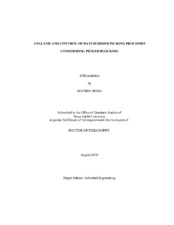| dc.description.abstract | Order picking operations play a critical role in the order fulfillment process of distribution centers (DCs). Picking a batch of orders is often favored when customers’ demands create a large number of small orders, since the traditional single-order picking process results in low utilization of order pickers and significant operational costs. Specifically, batch picking improves order picking performance by consolidating multiple orders in a "batch" to reduce the number of trips and total travel distance required to retrieve the items. As more pickers are added to meet increased demand, order picking performance is likely to decline due to significant picker blocking. However, in batch picking, the process of assigning orders to particular batches allows additional flexibility to reduce picker blocking.
This dissertation aims to identify, analyze, and control, or mitigate, picker blocking while batch picking in picker-to-part systems. We first develop a large-scale proximity-batching procedure that can enhance the solution quality of traditional batching models to near-optimality as measured by travel distance. Through simulation studies, picker blocking is quantified. The results illustrate: a) a complex relationship between picker blocking and batch formation; and b) a significant productivity loss due to picker blocking.
Based on our analysis, we develop additional analytical and simulation models to investigate the effects of picker blocking in batch picking and to identify the picking, batching, and sorting strategies that reduce congestion. A new batching model (called Indexed order Batching Model (IBM)) is proposed to consider both order proximity and picker blocking to optimize the total order picking time. We also apply the proposed approach to bucket brigade picking systems where hand-off delay as well as picker blocking must be considered.
The research offers new insights about picker blocking in batch picking operations, develops batch picking models, and provides complete control procedures for large-scale, dynamic batch picking situations. The twin goals of added flexibility and reduced costs are highlighted throughout the analysis. | en |


